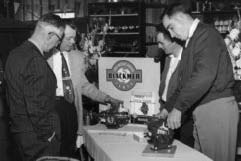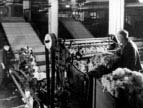12/21/2011
Read more about The History of Pumps here.
Design, vision, technology and a focus on efficiency have shaped the evolution of the pump industry.
The pump is one of civilization's earliest inventions. Considering its use in everyday life, it may be one of the most important. Since the beginning of time, there has been a need to push, suck or lift liquid from one place to another. Pumps provide the solution, dating back to 2000 BC when the Egyptians invented the shadoof. The physics of this first known pump was simple. A long suspended rod with a bucket on one end and a weight on the other was used to draw water from wells.

 |
| Above: An early 10 Series pump casting being machined on a vertical lathe. Photo courtesy of Gorman-Rupp Co. |
The Electronics Age
 |
| Pumps on display for a product demonstration in 1960. Photo courtesy of Blackmer |
Intelligent Pumps, Energy Efficient Motors & Drives
 |
| HydroAire mechanic Hank Deluca with a Byron Jackson pump that Hydro repaired for Inland Steel. Photo courtesy of Hydro, Inc. |
 |
| Photo courtesy of Freudenberg |
 |
| 52-year-old pump. Photo courtesy of GIW Industries |
 |
| Kalamazoo mechanical seal manufacturing and research lab in the 1950s. Photo courtesy of Flowserve |
 |
| Machine shop lathes department in Battle Creek, Mich. Photo courtesy of American Marsh Pumps |

